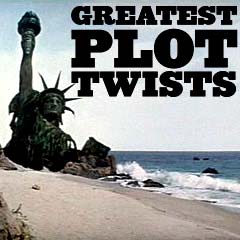
|
|
|
|||||||||||||||||||
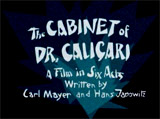 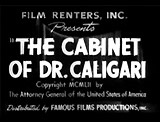
|
The Cabinet of Dr. Caligari (1920, Ger.)
The main plot of this influential German silent horror film from director Robert Wiene was about a mysterious, insane hypnotist-doctor and his somnabulist. It probably had the first or earliest twist ending ever in a movie. It also featured some of the earliest and best examples of expressionistic visual style, with distorted dimensions, twisted and tilted angles on alleyways and buildings, lopsided doors, cramped rooms, overhanging buildings, skewed cityscapes, and dark shadows (all precursors of film noir). In the film's prologue, Francis (Friedrich Feher) told a tale of the strange sufferings and horrible events that he had experienced, along with his 'fiancee' Jane Olsen (Lil Dagover). He was seated on a garden bench in a courtyard. The main body of the film was Francis' tale - a flashback. He described how he had attended the annual town carnival-fair in Holstenwall, with his friend Alan (Hans Heinrich von Twardowski). It was advertised as having "Entertainments of Every Variety." The two came upon the "spectacle" of the mad and sinister Dr. Caligari (Werner Krauss), who was advertising his exhibit with a life-sized poster, and encouraging fairgoers to enter his tent:
That same night was the first in a series of mysterious crimes which took place. The hot-tempered town clerk who issued permits for the carnival, was murdered - stabbed in the side with a strange pointed instrument. Back at the fair, Dr. Caligari opened his 'cabinet' - a large box-shaped coffin, and introduced a tall, slender, sleeping somnambulist named Cesare (Conrad Veidt) with a black leotard. He awakened Cesare from a death-like sleep - and his eyes slowly opened. He then proposed that the audience ask Cesare questions, since "Cesare knows every secret...knows the past and sees the future. Judge for yourselves. Don't hold back. Ask Away!" Alan asked the question: "How long will I live?" and was given the answer: "Till the break of dawn." After leaving the fair, Francis and Alan met up with Jane, and both admitted they loved her. Francis suggested: "We'll leave the choice up to her. But whomever she chooses, we shall remain friends." That night, as Cesare's prophetic prediction had stated, Alan was stabbed to death in his bed by a shadowy figure. Francis vowed to find who was committing these dreadful deeds, and immediately suspected the somnambulist. But then news came of the arrest of the suspected two-time murderer - not the somnambulist! A criminal (Rudolf Klein-Rogge) confessed to attempting a similar crime. Jane was also assaulted by Cesare with a long knife as she was sleeping, but because of her beauty, he hesitated to kill her. She was abducted rather than stabbed to death. During pursuit by a mob as he raced across rooftops and down alleys, Cesare released Jane unhurt, fell from exhaustion, and died. When Dr. Caligari was investigated later, it was found that the Cesare that Francis had been observing in the coffin at the time of the kidnapping was only a dummy. Dr. Caligari fled during the confusion, and entered a mental institution to hide. Francis followed after him there, where he asked the white-coated attendants: "Do you have a patient by the name of CALIGARI?" When he was permitted to speak to the asylum's director, he shockingly discovered that the man was Caligari. While Caligari slept in his villa later that night, Francis and other doctors searched through Dr. Caligari's office area, looking at his desk, books, and hand-written diary. They discovered that the insane doctor had become obsessed with somnambulism (Francis: "His specialty"). They found a book titled: The Cabinet of Dr. Caligari, that explained how the asylum's mad doctor was imitating a real, murderous 18th century Dr. Caligari:
To experiment with somnambulism, Dr. Caligari had made one of the sleepwalking asylum patients his 'Cesare'. When Caligari was shown the corpse of the patient, he went crazy. He exclaimed: "I must know everything. I must penetrate his secrets - I must become CALIGARI!" And then, the body of the murderous sleepwalker Cesare was found in a field, where he had died of exhaustion. Caligari was confronted:
When he was shown Cesare's corpse, Dr. Caligari collapsed, then had to be restrained, and put into a strait-jacket. He was now institutionalized, and Francis ended his story: "...and from that day on, the madman never again left his cell."
At the end of the tale (the film's epilogue), and with a return to the present, a twist ending was revealed. The entire film (a framed story with a flashback) was made up from the mad ramblings and delusions of Francis, the mentally-ill narrator/story-teller of the film while he was seated in the asylum courtyard. Francis was revealed to be a demented patient interred in the mental institution. Two other patients seen in his company were a crazed Jane (believing she was a Queen) and Cesare. Francis fearfully pointed out Cesare:
The last scene was of Francis becoming madly insane when he saw the asylum director Dr. Caligari. He insisted that the director was the sinister and tyrannical "Dr. Caligari" of his story:
When Francis grabbed Dr. Caligari and tried to strangle him, he had to be restrained in a strait-jacket and placed in a cell to be treated. Now that he understood Francis' illness, Dr. Caligari confidently stated that he had a sure-fire way to cure Francis' delusions:
|
 Francis (Friedrich Feher) Telling His Tale, Seated in Courtyard 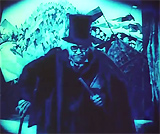 Dr. Caligari (Werner Krauss)  At Fair, Caligari Advertising Cesare 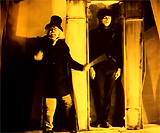 Opening of the Cabinet - With Somnambulist Cesare Inside 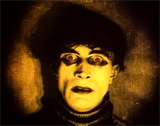 Cesare's Eyes Opening 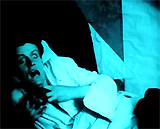 The Stabbing Death of Alan   Cesare About to Stab Jane - Then Abducting Her 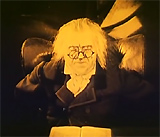 Dr. Caligari - Posing as The Asylum Director! 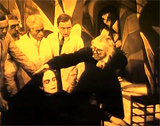 Dr. Caligari Examining Body of Sleepwalking Patient  Dr. Caligari With Corpse of Cesare 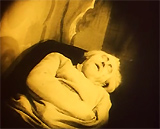 Dr. Caligari Restrained in Strait-Jacket - Accused by Francis' Story of Being Crazy |
|||||||||||||||||

|
The Cabin in the Woods (2012)
Director Drew Goddard's witty R-rated horror film (his feature-directing debut) was derived from a script he co-wrote with Joss Whedon. The self-aware, mischievous film, with plenty of in-jokes, had the tagline:
It was derivative of, and paid homage to earlier classic horror films, such as Sam Raimi's first two Evil Dead films (1982 and 1987), Ringu (1998, Jp.), Eli Roth's Cabin Fever (2002), Ju-on: The Grudge (2003, Jp.), the Scream films (1996-2011), Wes Craven's New Nightmare (1994), the works of H.P. Lovecraft, and the thematic set-up of The Truman Show (1998). Although it was actually shot in 2009, it was held up by MGM's bankruptcy, and then by new owners' Lionsgate that delayed the release for 3-D conversion (although it was eventually released flat). The principal characters (obvious archetypes), all young and sex-crazed college students, ventured in an RV to Curt's cousin's new place, the Buckner place - a "cabin in the woods" located on a rural lake (similar to Friday the 13th's locales):
Everything that the group did was monitored by a group of white-shirted and short-sleeved technicians in a high-tech control room or command center - two who conducted surveillance on the group were:
(There were similar projects underway in Sweden, Spain, Japan, and other countries around the world.) They were observing, manipulating, and betting on the outcome and fate of the choices of the characters - the film's slasher victims. The cabin was wired with hidden cameras, and the behaviors of the characters could be guided by pheromone sprays in the forest or mood-enhancing drugs. A large whiteboard, used by the scientists for betting which monsters would be picked, displayed dozens of horror categories, scenarios, and monsters to be selected for inclusion, i.e., Alien Beast, Vampires, Yeti, Sugar Plum Fairies, Dismemberment Goblins, Hell Lord, Zombie Redneck Torture Family, Deadites and Angry Molesting Trees. In the climactic conclusion, the last two survivors (Marty, immune to the technicians' drugs, and last remaining virgin Dana) who were fighting back against their manipulated enslavement, entered (via elevator) into the underground laboratory labyrinth. In the lower levels of the tech facility, they were spoken to, via the PA system, by The Director (Sigourney Weaver), who described the scenario that they had just acted out. They were five stereotypical teens doomed to die, to appease the "ancient ones" during an annual ritual sacrifice, as part of an ancient pact. Teens were fateful carnage for a blood-lusting Satan-like creature orchestrating the quasi-governmental organization to placate evil, to forestall a global apocalypse if the sacrificial scenario wasn't completed somewhere in the world. This time around, all of the other groups had failed:
In response, the two survivors unleashed an attack of many different creatures, including werewolves, spiders, mummies, zombies, ghosts, giant snakes, an Alien (1979) creature, killer robots, a Clive Barker-like Cenobite, and a killer clown. The technicians in the control room were among the victims, as was the Director. Marty and Dana decided not to follow the suggestion to die for the larger cause. In the film's final scene, Marty and Dana smoked pot together, and gave in to the sleeping, giant evil gods that was rumbling beneath them.
The Ancient One's gigantic hand and arm from the lower chamber rose up to destroy them. |
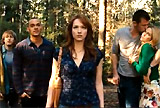 The Five Archetypal Horror Film Characters 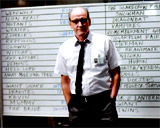 The White-board, and Technician Gary Sitterson (Richard Jenkins)  The Control Room 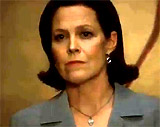 The Director (Sigourney Weaver) 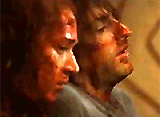 Two Survivors: Dana and Marty (Kristen Connolly, Fran Kranz) 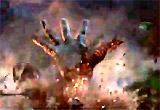 The Ancient One's Gigantic Hand |
|||||||||||||||||
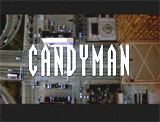
|
Candyman (1992)
This bloody modern horror film was based on Clive Barker's short story "The Forbidden." After the credits, the chilling film featured the title character's ominous voice-over heard over a massive honeycomb of swarming bees that were unleashed over the skies of Chicago -- clues to the frightening individual:
"Candyman" was coming for his latest 'victim':
Helen was a female student researching superstitions and urban legends, including the "Candyman" - a one-armed, hook-wielding maniac haunting Chicago's Cabrini Green project, where dozens of murders had occurred. She discovered that the "Candyman" could be summoned by repeating his name five times in a mirror. Hence, the film's tagline: "We Dare You To Say His Name Five Times!" During a dinner, one of Helen's senior professors, Professor Philip Purcell (Michael Culkin) explained the historical development of the legend - Candyman was the vengeful spirit of a former slave, who was raised in wealth and education, but was tortured and killed by "brutal hooligans" after falling in love with a white woman and impregnating her:
During her studies, Helen summoned the incarnated "Candyman" maniac (Tony Todd) - he had showed himself to her in a parking garage, to prove his existence. He kept repeating the words to her: "Be my victim."
He was implying that Helen's testimony about an attack by a copy-cat, hook-armed 'Candyman' assailant (Terrence Riggins), a local gang leader, had discredited and ruined his reputation amongst the Cabrini-Green residents in the slum housing project. By film's end, the 'Candyman' again found Helen in his company in his Cabrini-Green lair, and seduced her: "You came to me...Surrender to me now and you shall be unharmed." As the room spun around, he picked her up in his arms and promised her immortality:
Helen appeared to be the reincarnation of Candyman's lover from his past. He offered her: "Come with me and be immortal." He then revealed buzzing bees swarming on his chest and pouring from his mouth before he transferred the bees from himself to her when he kissed her ("Bee-Kiss"). However, he reneged on his promises and attempted to burn to death both Helen and Anthony. By film's end in the shocking conclusion of the bloody film, both of them (Helen and the haunting, incarnated 'Candyman' maniac) were consumed in a bonfire set in Cabrini-Green. Helen tried to escape but was trapped under burning beams, suffered massive burns, and later died (although she was able to save an infant baby named Anthony). Still mourning the death of his wife Helen after her funeral, cheating husband Trevor was in his bathroom when he called out Helen's name five times in front of a mirror, not knowing that he was invoking her return as a vengeful spirit that had replaced Candyman - she appeared in a bluish pulsating light and asked him:
Because he had been sleeping with another woman, a graduate student named Stacey (Carolyn Lowery) (who was in the kitchen with a long butcher knife preparing dinner), she took spectacular revenge against him. Helen killed Trevor by stabbing him in the stomach with the Candyman's large hook, ripping him open from his groin up to his neck - and leaving him a bloody corpse in the bathtub. Stacey found him and reacted in horror: "Trevor... My God, Trevor? Trevor? Trevor?" In Cabrini-Green, a painting of Helen with her hair ablaze on a wall was seen under the scrolling credits - she had entered the folklore of the legend. |
 The Skyline of Chicago, Bees, and Helen's Face 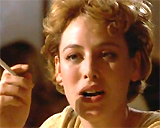 Helen Lyle (Virginia Madsen)  The Legend of Candyman - Told by Professor Purcell 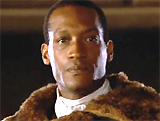 The Appearance of Candyman (Tony Todd) in Garage 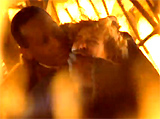 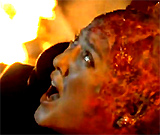 Helen's Death in the Bonfire in Cabrini-Green Housing Project  Helen's Cheating Husband Trevor Lyle (Xander Berkeley) Before Mirror after Helen's Death  Trevor Summoning Spirit of Helen By Calling Her Name 5 Times 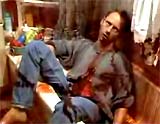 The Murder of Trevor 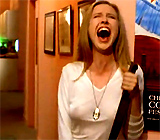 Stacey's Reaction to the Murder 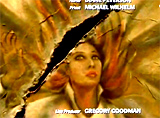 Wall Painting of Helen with Flaming Hair |
|||||||||||||||||
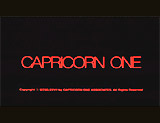
|
Capricorn One (1977)
Peter Hyams' socio-political, conspiracy thriller film hypothesized the problems of faking a flight to Mars on a soundstage in a television studio. It had an intriguing tagline:
The film opened with the failed Capricorn One mission - the first manned mission to Mars. Just before its launch, with NASA knowing that the faulty life-support systems would kill the astronauts upon reentry, the three crew members were removed from the space shuttle during a declared "emergency" and flown to an abandoned and remote US Army Air Corps base in the desert:
Once at the base, NASA director James Kelloway (Hal Holbrook) explained how NASA feared it would lose its space-program funding if the mission failed ("It was a mission that never got off the ground" - the trailer announced), so it was decided that they would fake everything. The space launch and landing proceeded ("This is Capricorn One, we have landed"), but with an empty capsule. The astronauts faked the footage during their flight to and from the red planet. They had reluctantly been pressured into creating a charade for the cameras. When flight control center technician Elliot Whitter (Robert Walden) recognized discrepancies in the transmissions, his suspicious journalist friend-reporter Robert Caulfield (Elliott Gould) resumed an investigation when all evidence of the technician and his life disappeared and were erased ("Something's wrong and I don't know what it is"). During the empty spacecraft's reentry, it burned up due to a faulty heat-shield, and the 'expendable' astronauts realized that they could never return to society or the hoax would be revealed. When they feared they would be terminated in the cover-up, they fled in a Lear Jet, although they crash-landed (after depleting their fuel), were stranded in the desert, and decided to split up to get back to populated areas. The only astronaut to avoid murder by NASA-hired assassins was USAF Colonel Charles Brubaker - he was the sole crew member left alive to expose the plot. With his own life in danger, reporter Caulfield met up with Brubaker, and during the 'live' memorial service at Arlington National Cemetery for the 'dead' astronauts as the US President (Norman Bartold) delivered a eulogy, they exposed the fraudulent mission. They pulled up in a car and ran through the rows of grave markers to the astonished, assembled group - ending on a freeze-frame. |
 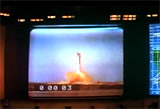   The Faked Mission  Fleeing in a Lear Jet  Freeze-Frame Ending of Astronaut Brubaker at His Own Memorial Srevice |
|||||||||||||||||
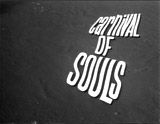
|
Carnival of Souls (1962)
This low-budget independent horror film, a spooky and haunting cult zombie classic by producer/director Herk Harvey (his sole feature film), was notable for its many atmospheric and forboding scenes of stylistic terror. The plot was very similar to the episode of the Twilight Zone titled "The Hitch-Hiker." In the film's opening, a drag race resulted in one of the cars crashing off a bridge into a muddy river and landing upside down. Of the three females in the car's front seat, it appeared that there was only one crash survivor (?) - passenger Mary Henry (Candace Hilligoss), a talented organist. As the story progressed after her near-fatal car accident, Mary moved to Utah to take a new job as a church organist. While driving there, she experienced one of many disturbing, creepy visions of ghostly figures of the recent dead. She was stalked by a weird vision of a ghoulish, Spectral Man (director Harvey) with darkened eye sockets, who first glared at her with an eerie stare through the windshield, and caused her to drive off the road. Mary also had moments when she became invisible and inaudible to others. She seemed to be caught between the real world and a dream-world. Later as the film drew to a close, she was lured to enter into a shadowy Pavilion's ballroom during a macabre party; she again envisioned ghoulish souls rising up in the salty water; and then inside the decaying dance hall, the lights turned on and she again saw a surreal "dance of death" performed by zombie-like ghouls or souls (a "carnival of souls") that she had already seen in her visions and on a bus; the dead spirits were twirling around as dance partners; Mary literally entered into the world of the dead; Mary realized that her actual dead doppelganger or double was dancing with the ghoulish Spectral Man.
She screamed in fright and ran off - as the camera motion was sped up while the soundtrack was distorted with laughter; she was chased by many of the undead, dark-eyed dancing partners all around the Pavilion and then to the beach, where she fell down in the sand during the pursuit - her collapsed body was completely surrounded by the heads of the zombies staring down upon her as the screen darkened.
The next day at the Pavilion,
Dr. Samuels, the Minister, and the Sheriff went searching for Mary
who had mysteriously vanished; the search party surveyed the sand
where Mary had fallen, with tracks of footprints in the sand leading
up to where she had collapsed - with a large imprint of her body
and an opened handprint; however, there was no sign of Mary's body;
the Sheriff announced how Mary's car had been found at the Pavilion's
gates nearby: (Sheriff: "Her car's still over there, and then
there are footprints leading up to here. And then nothing").
In the revelatory final scene's plot twist, back in Kansas, a man in a search boat called out to a tow-truck driver: "The car is right down there. Bring it on up"; he had recovered Mary's submerged car (with Mary's corpse inside along with her two friends in the front seat) - it was partially dredged out of the river. All three passengers didn't survive the crash. Her dreams, imagined visions and trances were due to her hallucinations during her death experience and entry into the spirit world. |
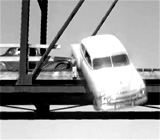 The Deadly Crash Off a Bridge 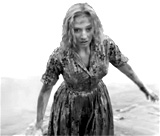 Mary's Survival of Crash (Spoiler: Imagined)   Mary's Visions of Ghouls/Souls Emerging From the Water 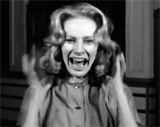 Mary Screaming in Horror at the Sight of Her Own Undead Dancing Self Inside the Pavilion 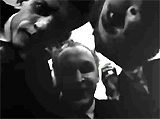 Mary Collapsing on Beach - Surrounded by Zombie Heads Staring Down on Her From Above |
|||||||||||||||||

|
Carrie (1976)
In the shock second ending to this De Palma horror film, surviving classmate Sue Snell (Amy Irving) was holding a bouquet of flowers. She was visiting the defiled gravesite of her student friend, dead psychic Carrie White's (Sissy Spacek). Carrie and her mother (Piper Laurie) had perished in their collapsing house. The grave had a graffiti-marked For Sale sign reading: "Carrie White burns in hell" and an arrow pointing downward. As Sue went to put the flowers on the grave, Carrie's bloody hand burst out of the ground at her and grabbed her arm to pull her down into hell with her - the white-clad young girl screamed and suddenly woke up. She was dreaming - while recuperating in her bed at home. She kept on screaming hysterically and being grabbed, while held by her reassuring mother (Priscilla Pointer) ("It's all right, I'm here") as she experienced more nightmares. |
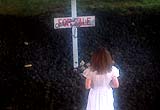  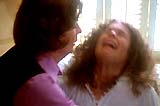 The Gravesite Visit: The Shock Ending |
|||||||||||||||||

|
This classic war-era film ended on a foggy airstrip in Casablanca, when cafe owner Rick Blaine (Humphrey Bogart) sacrificially chose patriotism over his personal love. He told teary-eyed former lover Ilsa Lund (Ingrid Bergman) to get on the plane departing for freedom with her husband Victor Laszlo (Paul Henreid):
Rick walked off with Capitaine Louis Renault (Claude Rains) across the wet runway into the misty fog, as Rick told Renault that they have forged a new alliance: "Louis, I think this is the beginning of a beautiful friendship" - their new partnership was underscored with the triumphant sounds of La Marseillaise. |
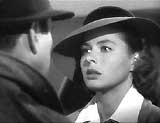 Rick With Ilsa at Airport Farewell 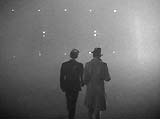
"A Beautiful Friendship" |
|||||||||||||||||

|
Catfish (2010)
The filmmakers of the quasi-documentary Catfish (2010), Henry Joost and Ariel (or "Rel") Schulman, were challenged to keep the startling revelation of the film from viewers in misleading trailers. The film's cryptic poster, with a drawing of a blood-red catfish, warned: "DON'T LET ANYONE TELL YOU WHAT IT IS." One of its taglines was:
It seemed to be a contrived, exploitative hoax and manipulative mystery story dramatizing the unusual circumstances, in order to capitalize on its anti-climactic, somewhat predictable conclusion. Some questioned its horror-film teasers. Many asked: how much was staged or misrepresented, and how much was true? It was a remarkable counter-point to the year's social-media hit, David Fincher's The Social Network (2010). In 2007, one of 24 year-old NY photographer Yaniv (or "Nev") Schulman's (the filmmaker's brother) photographs had appeared in The New York Sun newspaper. Three months later, Yaniv received a painting of his photograph in the mail. It had been sent by 8 year-old Abby Pierce living in rural Michigan. In response to the astounding painting of ballet dancers, and thinking that she was a child prodigy, he digitally sent her another of his photos to paint, and followed it by many more similar requests, giving her permission. Afterwards, he and Abby's family, including Abby's mother Angela (Wesselman), father Vincent (Stephen Fogarty) and her brother Alex, frequently corresponded by email and by phone - and online through Facebook - and he began to receive packages of Abby's paintings from Angela. He also engaged in a virtual, long-distance courtship-romance with Abby's beautiful 19 year-old step-sister Megan Faccio, an alleged artist, singer-musician (plays the cello), dancer, vet-animal lover and aspiring model. He later shared one sexy conversation that they had experienced together in a chat room with her (Megan after a proposed bath together: "I'd take you to my room and dry you off, touching every inch of you, kissing you long and hard to take your breath away...I want you so badly my body aches for you"). He first discovered deception when Megan sent a digital MP3 file of her singing the song "All Downhill From Here" - an exact duplicate of a recording sung by Amy Kuney (Nev: "She posted somebody else's music...It's not even her singing. It's just a recording of somebody else's song"). They also found another of Megan's pirated songs, "Tennessee Stud," the same exact recording from a YouTube video by Suzanna Choffel. Nev was astounded: "They are complete psychopaths. I've probably been chatting with a guy this whole time." He vowed: "I mean, that is enough for me to just never, ever talk to them again. Why should I waste time with this?" Realizing he had been duped, the gullible Nev also uncovered lies about their purchase of a remodeled main street building (the old JC Penney) in Ishpeming, Michigan that Abby claimed she used for her art gallery showings. However, after eight months of contact and correspondence, he decided to personally confront the family. The filmmakers and Nev flew to Chicago and then drove to Ishpeming, Michigan (on their way back to NYC from Vail, Colorado) to meet Abby and the other relatives. They first cruised by Megan's alleged horse farm in nearby Gladstone, Michigan at about 2:30 in the morning. In the mailbox, they found Nev's postcards with a red stamp: "Returned to This Address For Proper Disposition." It was obvious that Megan didn't live there. Then, the group dropped in unexpectedly on the other family members, where they had more predictable but shocking discoveries. The entire family had been misrepresented with numerous false claims, including the fact that Angela fabricated almost everything regarding Megan, Abby and herself:
In the film's epilogue, Vince explained the film's title:
The end notes mentioned that over the course of their 9-month correspondence, Angela and Nev had exchanged over 1,500 messages. It was stated that Angela deactivated her 15 other profiles and changed her Facebook profile to a picture of herself. She now had a website promoting herself as a serious artist. And Nev was still on Facebook, currently with 732 friends (including Angela). |
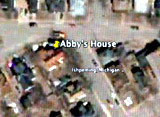 Abby's House (Ishpeming, Michigan) 
Nev Schulman 
"Angela" (Abby's mother) 
"Vincent" (Abby's father)  "Megan" (Abby's Half-Sister) 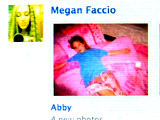 Pictures of "Abby" on "Megan's" Page  "Megan" and Nev Photoshopped Together  "Megan" (Aimee Gonzales) 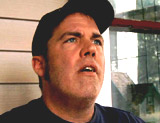 The "Real" Vincent |
|||||||||||||||||

|
The Cell (2000)
Director Tarsem Singh's stylish and innovative sci-fi, psychological thriller (his first feature film) was a combination of a typical police procedural (The Silence of the Lambs (1991) or Se7en (1995)) mixed with a virtual reality gimmick, as in The Lawnmower Man (1992). In the opening, child psychotherapist Dr. Catherine Deane (Jennifer Lopez) demonstrated her special empathic talent, coupled with a revolutionary new treatment technique. She entered into the mind of a comatose young boy named Edward Baines (Colton James) who nearly drowned on Seal Beach. As one of the researchers said of her risky VR journey:
A serial killer in rural Southern California, identified as sadomasochistic Carl Rudolph Stargher (Vincent D'Onofrio), was often accompanied by a rare albino German Shepherd (named Valentine). He had built a glass-enclosed "cell' in an underground chamber near an abandoned tin-sheeted building (near Exit 10 off Highway 99) where he kept each captive kidnapped victim (randomly grabbed) to torment. He would watch and record them on a set of four closed-circuit TV monitors as he meticulously fed and cared for them before slowly drowning them. With one recent victim, Anne Marie Vicksey (Catherine Sutherland), he gazed at her as she floated after drowning in the cell. In the basement of his small house, Stargher treated the body of his most recent victim: bleaching it in a milky substance (and turning it into a "doll"), then viewing it while suspended over the corpse, hung by 14 steel rings-hooks implanted into his back, and masturbating at his handiwork. Nearby, he displayed a grotesque collection of painted and pale child's play 'dolls', some of which were modeled in absurd postures in tableaus. Links signifying compatible empathy between Deane and Stargher were evident early on - for example, when Deane fed milk to her cat, there was a direct cut to a dead victim's milky-bleach bath. Stargher had just suffered from an irreversible coma during his apprehension by a SWAT team (he was tracked down by a hair from his rare albino dog). Dr. Deane was called upon by the FBI, led by Agent Peter Novak (Vince Vaughn), for a desperate favor. Since the comatose Stargher could not confess to the location of his recently-kidnapped eighth victim, Julia Hickson (Tara Subkoff), Dr. Deane was called upon to locate the information needed inside Stargher's mind. Her efforts were to discover the location of the missing female kidnap victim and rescue her from fateful drowning (automatically timed to occur within 40 hours) in the tank-cell. Deane entered into his twisted, depraved, damaged and bizarre psyche and mental landscape to confront his dreams and his persona, represented by inventive, disturbing visuals. When first entering Stargher's demented mind, she followed his younger version (Jake Thomas). She had found that one of Stargher's alter egos in his severe schizoid personality was a young abused boy. She saw how young Stargher was reliving how his abusive father had whipped him for playing with dolls ("I didn't raise no faggot"), burned him with an iron, river-baptized him (nearly drowning him) - with water representing both death and salvation, and broke three ribs and fractured his jaw when he was six years old. Others of Stargher's alter egos included more violent iterations: a Grand Guignol king with a purple cape on a throne, and an evil, demonic devil satyr with horns created out of human hair. Agent Novak was also compelled to enter Stargher's mind to search for a trapped Dr. Deane (taken captive by Stargher, wearing a neck collar and chain). Both risked insanity and death if they remained too long. Novak found himself struggling, bound and prone, as Stargher plaintively sang "Mairzy Doats" and disemboweled him with a large pair of scissors. In the end, a clue from the logo of the steel torture slab (and hoist), manufactured by Carver Industrial Equipment in Bakersfield, California, led them to the location of Stargher's trapped victim. Novak flew by helicopter, discovered the trap door leading to Julia's 'cell,' smashed the enclosure and rescued her just before she drowned. At the same time, without authorization, Deane reversed the feed and took Stargher into her own consciousness. Representing a Catholic Virgin Mary (wearing red and white), she took young Stargher into her trust. He admitted that his pathology started when he drowned an injured bird as a mercy killing ("It was better for the bird. I saved him") to save it from his father's torture. She then killed the murderous adult Stargher, by stabbing him in the heart with a sword, claiming: "My world, my rules." At the same time, she cradled the young Stargher in her arms as he also died and peacefully drowned in a baptism pool. As young Carl had saved the hurt bird, she also saved him from his beastly persona through mercy killing.
In the denouement, Dr. Deane adopted Stargher's albino dog, and used the reverse process to break through to her other young comatose patient Edward (her success was symbolized by blooming trees, falling snow, and an unbroken toy boat). |
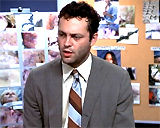 Agent Peter Novak (Vince Vaughn)  Dr. Deane (Jennifer Lopez)  Dead Victim Anne Marie Vicksey (Catherine Sutherland) 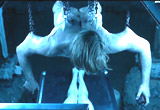  Sadomasochistic Serial Killer Carl Stargher Above Dead Victim 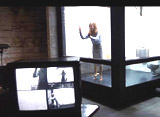 Recently-Kidnapped 8th Victim Julia About to Be Drowned in Tank-Cell 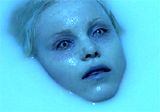 Milky Bleach Bath for Victim  One of Stargher's Grotesque 'Doll Models' in His Horrific Gallery of Tableaus  Stargher as Grand Guignol King With Purple Cape on Throne 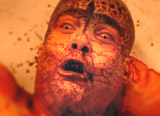 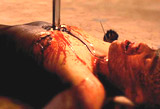 The End of Murderous Adult Stargher |
|||||||||||||||||
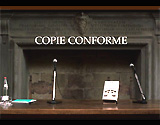
|
Certified Copy (2010, Fr.) (aka Copie Conforme)
This international arthouse film was written and directed by Iranian filmmaker Abbas Kiarostami, and a co-production of France, Italy and Belgium. Its star Juliette Binoche was awarded the Best Actress Award at the 2010 Cannes Film Festival for her performance. The main mystery of this bittersweet, provocative, dialogue-heavy film was the nature of the playful, puzzling and ambiguous relationship between the two protagonists. Was their meeting the first time, or had they known each other from before, or were they married to each other? In its mood, naturalistic and raw dialogue, there were similarities to the subject of Orson Welles' F for Fake (1973), and also reflections of the trilogy of 'Before' films:
The very cerebral film opened in the central Italian village of Arezzo in Tuscany with a book talk-conference delivered by British writer James Miller (William Shimell) about his latest work Copie Conforme (aka "Certified Copy"), recently awarded "the prize of the best foreign essay of the year." Its original title was - "Forget the Original, Just Get a Good Copy." In a reserved seat in the front row of the audience was an unnamed, French art-gallery/antiques dealer (Juliette Binoche), apparently a single mother who lived in Italy and was accompanied by her 11 year-old son Julien (Adrian Moore). He began his talk with musings on authenticity (originality) and fakery in art (diegesis vs. mimesis). The author stated emphatically that nothing was original, and that original artifacts were over-rated. Every reproduction was itself an original and even an original was a copy of another art form (i.e., the Mona Lisa was a copy of the original model it was based upon). He postulated that fakes or copies had the same legitimacy as originals, because they often led us to a better understanding of the original.
The distracted mother and restless son departed early before the book signing (she had bought 6 books) due to the boy's hungry appetite for a hamburger and Coke. She left her contact information with Miller's translator (Angelo Barbagallo). The author and the woman (known only as She or Elle in the credits) met up later in the day at her dark, below street-level boutique shop, and they decided to drive around the countryside together, under one condition: he had a train to catch at 9:00 pm ("I have to be back here at 9 for my train, nine o'clock"). They spent much of the day together wandering in the nearby rustic Tuscany town of Lucignano (often a favored place for marriages). At the town's museum (with a famous reliquary known as "L'albero Della Vita" (Tree of Life)) where they found themselves surrounded by couples in tuxedos and wedding gowns, they discussed the book's premise - the issue of authenticity in the arts (originals vs. reproductions or copies). They viewed a centuries-old revered painting that was actually a forged reproduction - still protected with a glass box and alarm system. At the cafe (as James took a cell-phone call), the owner-proprietor (Gianna Giachetti) was fooled into thinking that She and the man were a married couple. She explained her disappointment and frustrations with her 'husband' for working all the time: ("I didn't get married to live alone! I'd like to live my life with my husband. Is a good husband too much to ask for?..."), although the cafe-owner disagreed and thought work was a good thing for a man. Afterwards, She admitted to James that they had become believable as a married couple: "She mistook you for my husband. I didn't correct her." He responded: "Obviously, we make a good couple. What do you think?" They began to act as if they were a married couple, although in a relationship that had broken apart and was experiencing serious strains. Now during the course of their conversations, their spoken language shifted from English, to bits and pieces of their dialogue spoken in Italian and then in French. The premise of the book was related to their relationship: Were they authentic and real with each other, or only certified copies pretending? Were they faking or role-playing being married, with a false history and backstory? During a late lunch break, She excused herself to go to the restroom, to adorn herself with dangly costume jewelry earrings and bright red lipstick, as if she was playing 'makeup.' When she returned to the table, he was too busy arguing with the waiter over an inferior bottle of wine to notice her fresh attractiveness, and he insulted her with a sarcastic comment about her knowledge of wine: "Oh, you like it? How could I forget? The French know everything about wine!" As the movie ended, they spoke more and more convincingly about their relationship - they seemed to be a long-married couple of 15 years with a son, and it was their wedding anniversary. She asked him: "Remember the hotel of our wedding night?" - they went to the pensione nearby and requested a visit in Room # 9 on the third floor: "Could it be possible to take a look at it. It seems to be free. We want to remember that night." Inside the room, they talked about the passage of time and the changes they had undergone, and she appeared to be seducing him. He stood before the bathroom mirror, self-reflexively, before he decided to abruptly leave her (again?) - as church bells (wedding or funeral) pealed in the background:
|
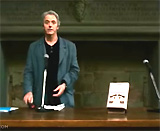 British Writer James Miller (William Shimell) 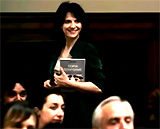 Audience Member She/Elle (Juliette Binoche) 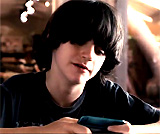 11-Year Old Son  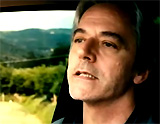 Driving Through Countryside 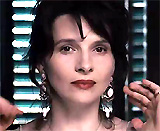 Playing at 'Makeup' 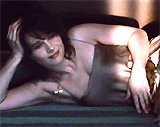 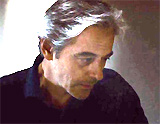 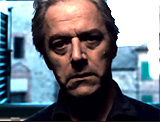 In Their Wedding Night Hotel Room |
|||||||||||||||||

|
Changeling (2008) Directed by Clint Eastwood, this drama-thriller about police incompetence in the aftermath of a kidnapping, and the subsequent actions of a courageous mother during a desperate search, was a true story that occurred in Los Angeles in the 1920s. The film was nominated for three Academy Awards, including Best Actress for Angelina Jolie. Its tagline:
The plot's storyline, set in 1928 Los Angeles, opened with the disappearance of nine year-old son Walter (Gattlin Griffith), discovered to be missing by single mother Christine Collins (Angelina Jolie) after she returned home late from work. She was aided in her tenacious quest for her son by benevolent activist Reverend Gustav Briegleb (John Malkovich) of St. Paul's Presbyterian. After five months, the inept, violent and corrupt Los Angeles Police Department, led by Chief James E. Davis (Colm Feore) and his "Gun Squad," announced that the boy had been found in DeKalb, Illinois. When reunited with his grief-stricken mother five months later at the train station, she claimed that 'Walter' (Devon Conti) was not her son but an obvious imposter (a changeling):
She was forced to take the strange boy home on a "trial basis" by the head of the LAPD's Juvenile Division, Captain J. J. Jones (Jeffrey Donovan), although she was steadfast when accused of shirking her responsibilities as a mother:
Challenging the Prohibition-era police authority, she pointed out two major differences between the two boys:
When she reported the discrepancies to the press, Christine was discredited, slandered and unjustly committed to Los Angeles County General Hospital's psychopathic ward (with a Code 12 internment order without a warrant), where she was subjected to a shower and invasive medical exam. She was diagnosed as being paranoid, dislocated from reality and delusional. She was taken under observation and forced to absolve the LAPD 'of all responsibility' for their actions. Meanwhile, Detective Lester Ybarra (Michael Kelly) was investigating a "juvenile matter" involving illegals from Canada in rural Wineville (Riverside County), CA. One of the apprehended male illegals from Canada, 15 year-old Sanford Clark (Eddie Alderson), claimed to Ybarra that his suspicious rancher cousin Gordon Stewart Northcott (Jason Butler Harner) held him against his will and threatened to kill him if he left the ranch. He confessed that child molester Northcott murdered 20 kidnapped boys (although one or two may have escaped), with Sanford's help - one of whom was identified by a photograph as Walter. The young boys were snatched from the streets of Los Angeles and detained in the dilapidated ranch's chicken coop before being hacked to death with an axe. To prove his words, Sanford dug up the area at the ranch where the bodies were buried. The news ("Kids found murdered in Riverside. Biggest crime in Los Angeles history. Collins boy assumed dead") forced authorities at the psychopathic ward to release Mrs. Collins. The fake 'Walter' admitted he had come to Los Angeles to see his cowboy idol Tom Mix and his horse Tony. During a trial involving LAPD incompetence, 'Walter' confessed that the police coerced him to lie about his identity: ("They said I was Walter Collins, not me! It wasn't my idea"). [Note: He was really Arthur Hutchins of Cedar Rapids, Iowa.] The trial-hearing ended with the permanent suspension of Captain Jones, and the removal of the Chief of Police. The suspicious child molester/murderer Northcott had fled as a fugitive to Vancouver, Canada to his sister's place, where he was apprehended and afterwards put on trial for the murders. He was found guilty and sentenced to hang in two years after serving solitary confinement at San Quentin, without confessing in person to Christine whether he committed the crimes or not just before his execution. Her last words to him were: "I hope you go to hell." In the film's epilogue, in the year 1935, another one of Northcott's kidnapped boys named David Clay (Asher Axe), was found alive. He described to Ybarra how one of the other abducted males with him was Walter, who bravely helped David escape: "All I know is, if Walter hadn't come back for me, I don't think I ever would have gotten out of there." However, he didn't know whether Walter was recaptured or got away. (Was Walter still alive?) He didn't tell anybody about his ordeal due to being scared:
Christine was given hope that after five years, one boy was found. She described her newfound confidence to Detective Ybarra in the film's final line of dialogue:
The final image in the conclusion was Christine walking across a downtown LA street as the camera boom rose up slightly, when the title stated: "Christine Collins never stopped searching for her son."
|
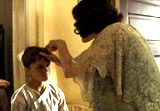 Mother Christine Collins (Angelina Jolie) With Actual Son Walter (Gattlin Griffith) 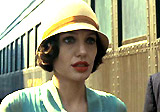 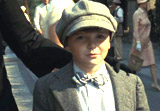 The Changeling at the Train Station 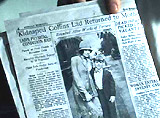 "Kidnapped Collins Lad Returned to Mother" - But He Was a Fake Imposter 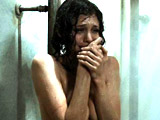 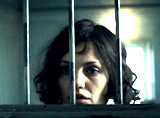 Christine Unjustly Committed to Psycho Ward 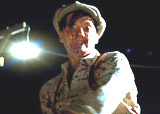 Child Molester and Murderer: Gordon Stewart Northcott (Jason Butler Harner) 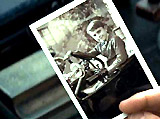 Walter Identified in Photograph  Confession of David Clay (Asher Axe) - One of the Surviving Kidnapped Boys |
|||||||||||||||||

|
The Changeling (1980, Can.)
Director Peter Medak's tense and unsettling haunted house entry was burdened with an unusual and confusing title. Although it turned out to be a major plot point, it wasn't made clear until about 3/4ths of the way through the film what it was referring to. The main character was:
He rented and moved into a haunted Seattle three-story mansion while working at his alma mater. He was still having nightmares and dealing with his own personal tragedy after witnessing the death of his wife Joanna and young daughter Kathy in a freak snow-plow accident in the film's opening during a winter vacation in upstate NY. The mansion rental deal in Chessman Park was facilitated by one of the historical society's workers Claire Norman (Trish Van Devere), although he was warned about the old gothic house:
Deeply-disturbing imagery, supernatural phenomena (a piano key pressed by an unknown presence, a broken window), and sounds (strange thumping and clanging noises, doors slamming, running faucets, whispering sounds, Kathy's rubber ball bouncing down the stairs, etc.) began to appear to Russell, as well as an apparition of a boy underwater (when he went to turn off a faucet that had partially filled a bathtub). He discovered a secret padlocked doorway behind a bookcase, leading from the 3rd floor up to the attic, where he found a dusty, cob-web covered children's room. In it was a music box, playing the same tune that he had been composing on the piano. Investigating with Claire, Russell first found an historical record in the local library that a local girl named Cora had been killed near the house by a coal truck - similar to the death of his own daughter.
During a seance, a frenzied medium received ghostly answers to her questions, not from Cora, but from a spirit named Joseph, and a large cone-shaped object sailed across the room. Russell received further communicative manifestations from the poltergeist - a crippled young boy named Joseph Carmichael - when he replayed a tape recording of the seance. He discovered that the six-year old boy had been murdered (drowned) by his father Richard Carmichael in the attic's bathtub in the early 1900s. [The thumping noise was the sound of the boy's frantic fist banging on the side of the tub during the horrific murder.] And it appeared that the six term, powerful, wealthy and elderly US Senator Joe Carmichael (Melvyn Douglas), the local symphony's benefactor, was somehow involved and wanted to keep it covered up. In the film's conclusion, Senator Carmichael was revealed to be "the changeling" - an imposter or fake son Joseph. After the secret murder of the real Joseph during his bath in the attic, the scheming father Richard led everyone to believe that he had taken the sickly boy to Europe (for special therapy in a sanitarium). In fact, he had substituted a boy (the future Senator) from the local Sacred Heart orphanage in his place, in order to inherit the boy's fortune. Richard's motive to replace the sickly and arthritic Joseph was greed, since his deceased wife's multi-million fortune was willed to Joseph, whom Richard feared wouldn't live to the age of 21, long enough to acquire the wealth. Then, after a miraculous recovery in Europe, the imposter boy "returned to inherit an empire." The real Joseph was buried in a deep well on the Carmichael's family ranch (now existing under a house where a young girl's bedroom was located, and where she experienced nightmares of an emaciated boy reaching for her). A digging under the floorboards found skeletal bones and the boy's baptism medal in the dirt of the well.
Russell confronted the aging Carmichael in the Senator's home with the entire story about the murdered son ("That changeling was you"), but he denied the truth of it. Russell was offered blackmail money to keep silent ("All right, how much do you want for this farce that you've concocted?") but refused. Russell vehemently chastised Russell:
The Senator berated Russell for accusing his father (actually step-father) of murder: "My father was not a murderer...My father was a great man, a loving man...I will not allow you to slander his good name." Before departing, Russell left the real medal with the Senator, found in the burial digging. When the Senator placed the real medal on a portrait of foster father Richard on his desk, her heard the doomed boy crying: "My medal" - and then "Father, don't!" before it began to violently shake. The Senator became hypnotized and had an out-of-body or dream-like experience - his illusionary double entered the burning mansion, climbed the flaming stairs to the attic, and saw the same vision of Joseph's drowning death at the hands of his father. Then, back at his own home, the Senator suffered a fatal heart attack as the attic exploded. He was wheeled into an ambulance from his home. At the same time, Claire had rescued Russell from the mansion that was burning to the ground. The next morning, the camera zoomed toward the burning embers of the mansion, and focused on Joseph's burned-up wheelchair, and his music box that suddenly clicked open and began playing a lullaby. Justice seemed to have finally been attained.
|
 The Rented Gothic Mansion   Apparition of Boy (Joseph Carmichael) Underwater  The Drowning of Joseph Carmichael  Joseph's Skeletal Bones  US Senator Joseph Carmichael (Melvyn Douglas) - "The Changeling" - Comparing the Real and Fake Baptism Medals   Placing Real Medal on Portrait of Father Richard Carmichael   The Senator's Illusionary Double Climbing the Flaming Mansion Stairs to Attic  Russell Saved From Burning Mansion  The Senator's Fatal Heart Attack in His Home |
|||||||||||||||||

|
Charade (1963)
In this clever and sophisticated suspense comedy/mystery, the recently-widowed and elegant Regina "Reggie" Lampert (Audrey Hepburn) found herself pursued by many harrassing men, even though she was penniless after her husband Charles was brutally murdered by being thrown from a train (she was planning on divorcing him anyway). She became extremely vulnerable and apprehensive after learning that her husband stole government money during WWII, and feared that his double-crossed victims (all Army war buddies) wanted to locate the lost or hidden gold treasure worth $250,000. The Army buddies included:
One of the men who also seemed to be in pursuit was the enigmatic yet suave Peter Joshua (Cary Grant) - raising the question: Were the beguiling Joshua's motives honest and above reproach, or was he hiding secrets from her, and not disclosing his true identity? The man identified as CIA administrator Mr. Hamilton Bartholomew (Walter Matthau) was actually revealed to be Carson Dyle, who had survived being shot by the Germans, and was killing off his back-stabbing Army buddies to get at Charles' money. By the film's conclusion, it was revealed that alias Peter Joshua (going by four different names, including Alexander Dyle (Carson's brother), and Adam Canfield) was really Mr. Brian Cruikshank of the Treasury Department when his secretary buzzed him in his office. He made a surprise proposal of marriage to Reggie in his office to end the film:
It was also revealed that the treasure - the subject of the frenzied search within the film - had been converted into valuable and rare stamps by Reggie's estranged husband Charles just before he was murdered:
|
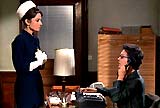 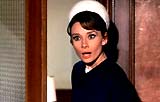 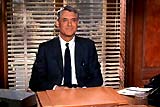 
Reggie (Audrey Hepburn) With Brian Cruikshank (Cary Grant) |
|||||||||||||||||

|
The Children's Hour (1961)
This film was based upon Lillian Hellman's hit Broadway play The Children's Hour - and was first filmed by William Wyler as These Three (1936). It was extremely bowdlerized due to restrictions imposed by the Hays Office. In the earlier drama of 1936, the rumor and accusation of a lesbian relationship between two teachers was changed to an illicit, though heterosexual, love affair (and romantic triangle) between one of the teachers and her colleague's fiancé. This 1961 film remake by Wyler also had to avoid the word 'lesbian.' It told a serious story of female attraction between two headmistress-teachers at the Wright-Dobie School for Girls:
Their 'affair' was witnessed (during eavesdropping outside their door) and reported by mean-spirited, vindictive, and manipulative 12 year-old student Mary Tilford (Karen Balkin) - the act was seen as unnatural, "bad things." Mary's scandalous lie, to remove herself from a school where she was disliked, had devastating after-effects for the school and its administrators. It even created doubts in the mind of Dr. Joe Cardin (James Garner), Karen's fiancee who was planning on marrying her. Karen suggested to Martha that they go away somewhere to make new lives for themselves ("Let's pack and get out of here. Let's take the train tomorrow...There must be someplace we can go"). In a heart-rending, devastating, and overacted scene, self-loathing Martha realized that the child's lie had uncovered her own suppressed lesbian-tinged emotions, although she tried at first to deny them. She broke down and hysterically confessed how 'guilty' and 'sick and dirty' she felt about her love feelings toward Karen:
In the somber and despairing ending, she committed suicide (by hanging herself in her room - her dangling feet seen in shadowy silhouette, behind an overturned chair) when she realized that the lesbian rumors about herself were true. |
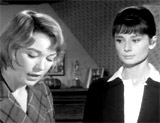 (l to r): Martha and Karen 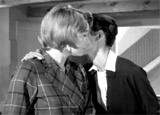 The Alleged "Affair" 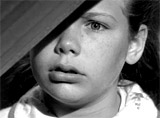 Mary Tilford Watching 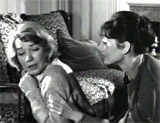 Distraught Reactions 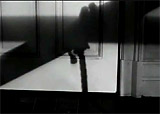 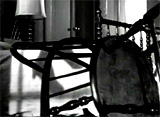 Martha's Suicidal Death |
|||||||||||||||||